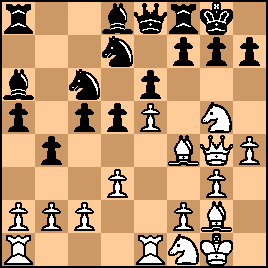| Feb-08-05 | | MidnightDuffer: Speaking of sacs, here is a game, where even Uhlmann in the French, King's Indian Attack by White gets into trouble rapidly; |
|
| Feb-08-05 | | aw1988: 14...a4?? |
|
| Jul-22-05 | | notyetagm: See Rublevsky vs E Vorobiov, 2003 for the exact same winning combination. |
|
| Aug-06-05 | | rangarajachary: whats the ending? |
|
| Aug-06-05 | | hippatxu: <rangarajachary> after 15...fxe6 16.♕xe6+ and 17.♕xc6 white is 2 pawns up with a better position (pawn on e5 roolz). |
|
| Jan-22-07 | | sahmattr: 15... fxe6 16-Qxe6+ Kh8 17-Qxc6... it is a loss for black |
|
| Jan-22-07 | | Shams: boner move by Uhlmann...he must have been hitting the Lowenbrau a little hard the previous night. how does white prosecute things after 14...Bd8 <?> |
|
| Nov-04-07 | | hesyrett: Actually, Bronstein's 14. ♕g4 looks questionable. Uhlmann could have played 14...♘d4 Δ 15...♘xc2, or as suggested by <Shams>, 14...♗d8 leaving that threat in the air. The White ♕ has left c2 unguarded and is in the way of the thematic ♘f1-h2-g4. |
|
| May-17-08 | | hamham: Can I ask something really stupid? Why doesn't black play 13. h6, for what reason? If my opponnent plays that, what should my response be and why?
Thnx for any comments.
I played a KIA game today without knowing any theory. And looking at all the GM games, I played it all the right moves (only losing after making an unsound sac). |
|
| May-17-08 | | Ziggurat: <hamham> My guess would be that black did not play 13...h6 because he didn't want to weaken the pawn structure in front of his king. (The g6 square gets weakened, and the h6 pawn itself may become a target of attack.) I think white can respond by either 14. Nf3 or 14. Nh3. 14. Nxe6 does not seem to work here. |
|
Jun-29-09
 | | FSR: Yes, I think Uhlmann was afraid of 13...h6 14.Nh3, perhaps followed by Nh2, Qh5, Ng4 and Black will have to worry about a sac on h6. |
|
| Mar-28-11 | | Everett: <hesyrett: Actually, Bronstein's 14. g4 looks questionable. Uhlmann could have played 14...d4 15...xc2, or as suggested by <Shams>, 14...d8 leaving that threat in the air. The White has left c2 unguarded and is in the way of the thematic f1-h2-g4.> At first glance, after 14..Nd4 15.Ne3 white is fine and still on the attack. |
|
| Jan-05-17 | | Swedish Logician: Half a year later at Amsterdam, Walter Browne, Browne vs Uhlmann, 1972, deviated from 14. Qg4 against Uhlmann. He must have suspected an improvement for Black. Larsen once wrote that it is very important to seek and find improvements for the losing side in a well-known game, and who better to dao so than the loser? |
|
Jan-16-22
 | | louispaulsen88888888: < Actually, Bronstein's 14. ♕g4 looks questionable. Uhlmann could have played 14...♘d4 Δ 15...♘xc2, or as suggested by <Shams>, 14...♗d8 leaving that threat in the air. The White ♕ has left c2 unguarded and is in the way of the thematic ♘f1-h2-g4.> What do you do about just defending c1 with Ne3 or Rac1. Seems like white is a bit ahead after either move. |
|
Nov-30-24
 | | PawnSac: < Shams: how does white prosecute things after 14...Bd8 ? > 
click for larger view14...Bd8 is actually the best move, according to Stockfish, which gives the following candidate moves: 15. Nd2
15. a3
15. Nh2
54/75 +0.09 14. ... Bd8 <15.Nh2> a4 16.Qd1 Ne7 17.Ng4 Ba5 18.b3 Bb5 19.Nf3 Nf5 20.Ne3 Nxe3 21.Bxe3 d4 22.Bf4 Bc6 23.Nd2 Bxg2 24.Kxg2 Bc7 25.Qg4 Kh8 26.Nc4 f6 27.h5 Qf7 28.exf6 Nxf6 29.Qh4 Bxf4 30.Qxf4 Qxh5 31.Re5 Qe8 32.Rae1 Ra6 33.Kg1 axb3 34.axb3 Nd7 35.Rf5 Rxf5 36.Qxf5 h6 37.Qf4 Ra2 38.Rc1 Qf8 39.Qc7 Nf6 40.Qb7 55/72 +0.14 14. ... Bd8 <15.a3> Bc7 16.Nf3 Kh8 17.Qh5 Rb8 18.axb4 Nxb4 19.Rec1 Bb5 20.Ne3 h6 21.Ng4 f5 22.Qxe8 Rfxe8 23.Ne3 Kg8 24.b3 Rec8 25.Nd1 Bc6 26.Nb2 Bb7 27.h5 Kf7 28.Na4 Bc6 29.Nb2 Ba8 30.Na4 Bb7 31.Nb2 Nc6 32.Re1 Nd4 33.Nxd4 cxd4 34.Bf3 g5 35.hxg6+ Kxg6 36.Bd1 Re8 37.Kf1 h5 38.Bd2 Nxe5 62/85 +0.04 14. ... Bd8 <15.Nd2> h6 16.Nh3 Kh8 17.a3 bxa3 18.Rxa3 Bc7 19.Nf3 Ne7 20.Nh2 Rb8 21.Qd1 Ng6 22.Qh5 f6 23.Bd2 Bc8 24.Ng4 Ngxe5 25.Qxe8 Rxe8 26.Nxe5 Nxe5 27.Bxa5 Bd6 28.Ra2 g5 29.f4 gxf4 30.Nxf4 Kg7 31.Rf1 f5 32.Bd2 Re7 33.Nh5+ Kg6 34.Nf4+ Kh7 35.Re1 Nc6 36.c4 Nb4 37.Bxb4 Rxb4 38.cxd5 e5 39.Ne6 e4 40.Nf4 Bb7 41.dxe4 fxe4 |
|
Sep-13-25
 | | PaulPetrovitj: Uhlmann later commented that after 14. Qg4 Black's best move is 14.-, Kh8. The game Browne-Uhlmann, Amsterdam 1972 as mentioned above, is in my opinion a very instructive example of Black's possibilities on the Q-side in this variation. For most of us, White's initiative on the K-side looks much more promising than Black's on the Q-side, so this game is worth studying. Uhlmann: Französisch, richtig gespielt (French - played in the correct manner) is a good book on the French Defence. |
|





